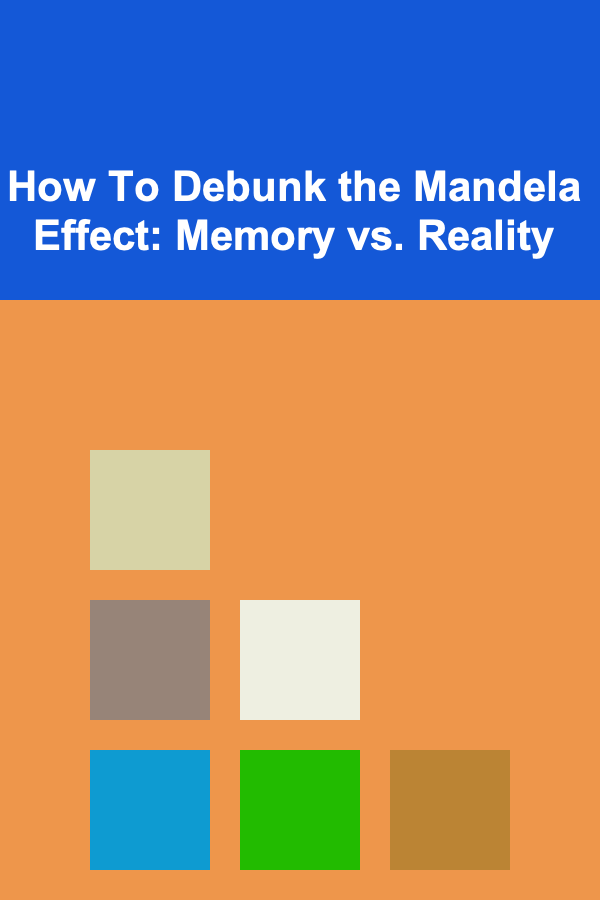
How To Debunk the Mandela Effect: Memory vs. Reality
ebook include PDF & Audio bundle (Micro Guide)
$12.99$9.99
Limited Time Offer! Order within the next:

The Mandela Effect is a phenomenon that describes the collective misremembering of an event, fact, or detail that is widely recognized and accepted. This effect takes its name from the incident in 2010 when many people falsely remembered former South African president Nelson Mandela dying in the 1980s, even though he was still alive at the time. The Mandela Effect has since expanded to cover a wide range of cases, from misquoted movie lines to the recollection of historical events.
But how can we explain these widespread misconceptions? How do we differentiate between faulty memory and objective reality? The Mandela Effect challenges our understanding of memory and cognition, but it can be debunked through a deeper understanding of the ways our brain processes information. In this article, we will explore the science behind the Mandela Effect, how memory works, and how it can be distorted to create false memories that seem real. By understanding the mechanisms of memory and perception, we can begin to demystify the Mandela Effect and recognize the divide between memory and reality.
Understanding Memory and Cognitive Bias
To understand the Mandela Effect, we must first explore how human memory functions. Memory is not a perfect recording of events; instead, it is a reconstructive process that can be influenced by a variety of factors. Our brains are constantly processing and organizing information, but the way we encode and recall memories is not always accurate. The following concepts are key to understanding why memories can be faulty:
1. The Fallibility of Memory
Memory is not a static, unchangeable entity. It is malleable and can change over time. Our recollections are not always accurate representations of past events but are instead influenced by external factors, such as suggestions from others, emotions, and even our own biases. The brain tends to fill in gaps in our memories by drawing on available information, which can lead to the creation of false memories.
For example, imagine you are asked to recall a specific event from your childhood. Over time, your recollection of the event might shift as new details are added or old ones are forgotten. These changes can be subtle, but they can ultimately result in a memory that no longer aligns with the actual event.
2. The Role of Cognitive Bias
Cognitive biases are systematic patterns of deviation from norm or rationality in judgment, whereby individuals create their own subjective reality. They play a significant role in how memories are formed and recalled. One common cognitive bias that contributes to the Mandela Effect is confirmation bias. Confirmation bias occurs when we focus on information that supports our pre-existing beliefs or expectations while disregarding evidence that contradicts them.
In the context of the Mandela Effect, confirmation bias can lead individuals to selectively remember information that fits a particular narrative. For example, people who believe that a historical event occurred in a specific way might be more likely to recall details that support this belief, even if those details are inaccurate.
3. The Impact of Social Influence
Social influence is another factor that can shape memory and perception. When individuals share similar experiences or memories, they may begin to reinforce each other's false recollections. This is particularly evident in the Mandela Effect, where groups of people collectively recall events or facts incorrectly. Social media and online communities have played a significant role in spreading these collective memories, as people are often exposed to similar false information that reinforces their beliefs.
The psychological phenomenon of social contagion refers to the spread of emotions, behaviors, or beliefs within a group. In the case of the Mandela Effect, social contagion can result in the widespread acceptance of incorrect memories, especially when influential figures or communities validate those memories.
The Mandela Effect: A Brief Overview
The Mandela Effect gained popularity after many people mistakenly believed that Nelson Mandela had died in the 1980s while imprisoned, despite the fact that he was released in 1990 and passed away in 2013. This widespread misremembering led to the coining of the term "Mandela Effect" by Fiona Broome, a paranormal researcher, in 2009. Broome noticed that she wasn't the only one who had vivid memories of Mandela's death, and as she discussed the phenomenon with others, she discovered that many people shared the same false memory.
Since then, the Mandela Effect has expanded to include various examples of collective misremembering. Some of the most well-known instances include:
- The Berenstain Bears: Many people remember the popular children's book series being spelled as "Berenstein Bears," with an "e," rather than "Berenstain Bears," with an "a."
- The Location of New Zealand: Some people insist that New Zealand used to be located to the northeast of Australia, but in reality, it is to the southeast.
- The Monopoly Man's Monocle: Despite widespread belief, the Monopoly Man, the mascot of the board game, has never worn a monocle.
- Looney Tunes: Some individuals recall the animated series being spelled "Looney Toons," but it has always been "Looney Tunes."
While these examples may seem trivial, they highlight the ways in which our memories can be altered and manipulated, often without our conscious awareness. The Mandela Effect raises important questions about the reliability of memory and the role of perception in shaping our understanding of reality.
How to Debunk the Mandela Effect
Now that we understand the basic principles of memory and cognition, we can begin to debunk the Mandela Effect. The key lies in examining the psychological and neurological factors that contribute to these collective misremembrances. Here are several strategies to help explain and debunk the Mandela Effect:
1. Cognitive Science and the Malleability of Memory
As previously mentioned, memory is not a perfect record of the past; it is a reconstructive process that is influenced by various factors. One of the key insights from cognitive science is that memory can be distorted by the way information is encoded, stored, and retrieved. The brain is constantly making predictions about the world based on prior knowledge and experiences, and this process of prediction can sometimes lead to errors in memory.
For instance, when recalling an event, our brain may fill in gaps with information that seems plausible but is not actually accurate. This can lead to the creation of false memories. These memories feel real to the individual, even though they may be entirely fabricated or altered by external influences.
2. The Role of Misleading Information
Misleading information can significantly impact memory. Studies have shown that when people are exposed to incorrect details after an event, those details can become incorporated into their memories. This phenomenon is known as the misinformation effect. In the case of the Mandela Effect, it is possible that people have encountered misleading information---either through word of mouth, media, or social networks---that has caused them to misremember an event or fact.
For example, the widespread online discussion about Nelson Mandela's supposed death in the 1980s may have led many individuals to incorporate this false detail into their memories. Similarly, when people repeatedly encounter the incorrect spelling of "Berenstein Bears," they may begin to remember it as "Berenstein," even though it has always been "Berenstain."
3. The Power of Suggestion
The power of suggestion is another key factor in the Mandela Effect. If a person is told that something is true, they may begin to accept that information as fact, even if it contradicts their own memories. This phenomenon is known as suggestibility. People are often more likely to accept suggestions when they come from a trusted source, such as a friend, family member, or media outlet.
For example, if someone tells you that the Monopoly Man has a monocle, you might begin to "remember" seeing him with one, even though he has never actually worn one. The more times you hear this suggestion, the more likely you are to incorporate it into your memory, even though it is false.
4. The Influence of Collective Memory
The Mandela Effect is often a product of collective memory, where large groups of people share the same false recollection of an event or fact. Collective memory can be influenced by social factors, such as groupthink, social contagion, and media exposure. When people are exposed to the same misinformation, they are more likely to adopt that misinformation as their own memory.
For example, the widespread belief that "Looney Toons" is spelled with "oo" rather than "ue" may have originated from a misheard or misremembered detail that was later reinforced by others. As more people began to believe this false recollection, it became part of the collective memory, even though it was never true.
5. The Importance of Critical Thinking
One of the best ways to debunk the Mandela Effect is to apply critical thinking and skepticism to the information we encounter. Rather than accepting false memories or misinformation as fact, we should question our recollections and seek out evidence to support or disprove them. The more we question the accuracy of our memories and the information presented to us, the better equipped we will be to separate reality from illusion.
For example, if you are unsure whether the Berenstain Bears is spelled with an "a" or an "e," a quick search on the internet can provide you with the correct spelling. Similarly, if you are uncertain about the location of New Zealand, checking a map will confirm its true position relative to Australia.
Conclusion: Memory and Reality
The Mandela Effect highlights the malleability of memory and the ways in which our perceptions of reality can be shaped by cognitive biases, social influence, and suggestion. While the phenomenon may seem mysterious or even paranormal, it can be explained through a deeper understanding of memory science and the cognitive processes that underlie our recollections.
Ultimately, the Mandela Effect serves as a reminder that memory is not a perfect reflection of reality. Our brains are constantly reconstructing and interpreting the world around us, and this process is subject to error. By understanding the psychological and neurological mechanisms that contribute to false memories, we can better appreciate the gap between memory and reality. The Mandela Effect may seem like a mystery, but when viewed through the lens of cognitive science, it becomes a fascinating example of how the mind works---and sometimes misfires.
By cultivating critical thinking, questioning our memories, and seeking out evidence, we can navigate the complexities of memory and reality with a more informed perspective, ultimately debunking the Mandela Effect for what it is: a fascinating and perplexing quirk of the human mind.

How to Arrange Vintage Finds in a Cohesive Style
Read More
How to Incorporate Minimalist Holiday Decor into Your Home
Read More
How to Make the Most of Dividend Investing for Steady Income
Read More
How to Plan for Financial Security as a Single Parent
Read More
The Application Support Analyst's Guide to Troubleshooting and Optimization
Read More
How to Build a Productive Remote Team for Your Small Business
Read MoreOther Products

How to Arrange Vintage Finds in a Cohesive Style
Read More
How to Incorporate Minimalist Holiday Decor into Your Home
Read More
How to Make the Most of Dividend Investing for Steady Income
Read More
How to Plan for Financial Security as a Single Parent
Read More
The Application Support Analyst's Guide to Troubleshooting and Optimization
Read More